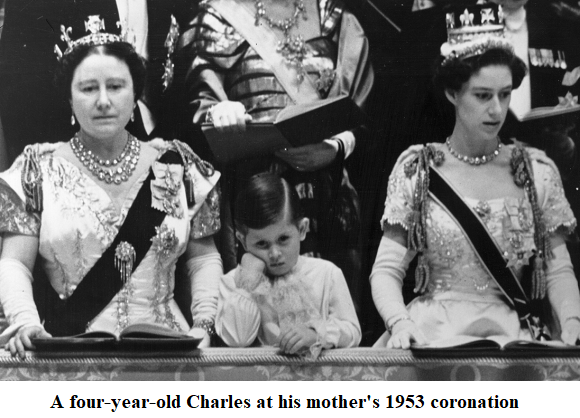
It was said of Queen Victoria and her son (eventually Edward VII), “The Queen continues to reign, and reign and won’t let the son shine.” It might be said of her great-great granddaughter, Elizabeth, “The Queen continued to shine, and shine and wouldn’t let the son reign.” But if one looks to her coronation, held seventy years ago in June, it is not difficult to see why she felt bound to retain the reins and make her septuagenarian son await her death.
Now that Charles’s turn has come, Hugo Vickers’ authoritative and fascinating Coronation (Dovecote Press, 2023) is timely as it sheds light on the mystery and magic of that last Coronation. This slim work is full of gems — characters and anecdotes woven through the pageantry and prayer. One key character is the MC, the Earl Marshall – always the premier duke, the Duke of Norfolk. In 1953, it was Bernard, the efficient, precise 16th Duke with a fine sense of ceremony and astonishing eye for detail.
When a divorced peer expressed concern about not being invited, Norfolk retorted, “Of course you will. This is a Coronation; not Royal, Ascot.” His duchess, Lavinia, stood in for the Queen at rehearsals and she was one of 13 duchesses sitting in the front row. A splendid sight, according to diarist Chips Channon MP. In fact, the Abbey was packed with peers in 1953. The reformist John Grigg had suggested that they might be “replaced by eminent Canadians, Australians, Pakistanis and other Commonwealth leaders” but he met a wall of opposition from the Archbishop of Canterbury and the Earl Marshal and so, as in the past, there was a galaxy of coronets.
But on Saturday, it seems there will be only a handful of dukes. The others will presumably be watching the tele from their sitting rooms or libraries at Auchmar, Chatsworth, Blenheim, Baron’s Court, Goodwood, Alwnick and Floors. Apart from some nobles in attendance for other reasons and achievements, there will be a mere 25 peers. And 25 MPs. Instead, the hoi polloi will fill many of the pews – 850 community and charity workers including some 450 British Empire Medallists – the most modest of all the honours but those awarded on effort and not rank.
Prime Minister Robert Menzies was there 70 years ago, accompanied by his wife, Pattie, and their 20-year-old daughter, Heather, who, at 94, must be one of the very few Australians who attended the Coronation and are still with us. It was Menzies who suggested that part of the Regalia, the traditional solid-gold armills (bracelets, below), which dated from 1661, might be replaced. This was taken up and new ones crafted by the crown jewellers were presented to and worn by the Queen, a gift from all the Commonwealth. Sir Robert, an enthusiastic shutterbug, also produced a home movie of the coronation which can be viewed via this link.
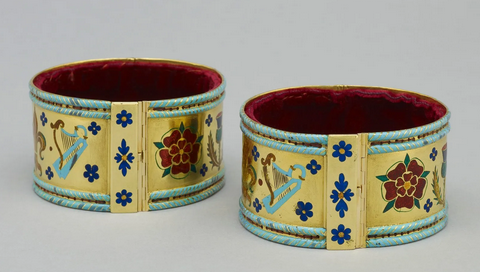
National interest was intense and the Australian press followed the Menzies’ every move. One might say ‘every movement‘ as the Maryborough Chronicle splashed on 30 June 1953, towards the end of the visit, ‘MENZIES HAS GASTRO’.
Former PM and retired Australian High Commissioner Stanley Bruce was also there to witness the crowning of the Head of the Commonwealth (a title coined and acquired only two years before). So was HV ‘Doc’ Evatt as Leader of the Opposition. Today’s Prime Minister, though a Republican, has pledged allegiance to His Majesty and stated that Australia would remain a monarchy until at least the next Parliamentary term. The loyalty of the states has been acknowledged and all Australian state Governors will attend, though not, it seems, their husbands or wives. There must be some pretty grumpy gubernatorial consorts about this weekend, glowering in their London hotels or furiously idle at home.
In 1953, a young reporter, the Washington Times-Herald’s ‘Inquiring Camera Girl’, one Jacqueline Bouvier, was sent to London to report. She reported “All the deposed monarchs are staying at Claridge’s”.
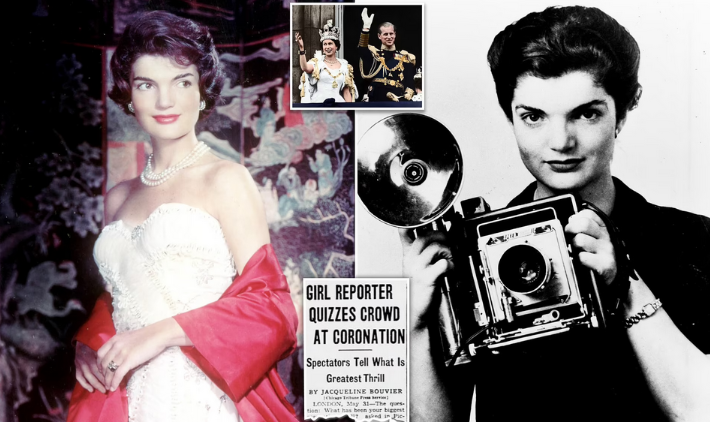
Well, not all — one of them, the Duke of Windsor, who sailed with her on the SS United States — disembarked with his duchess, and their pugs, at Le Havre. Those Windsors were not bidden. In London, Miss Bouvier asked spectators outside Buckingham Palace, “Do you think Elizabeth will be England’s last queen?” Three weeks later, at home, she was engaged to John F Kennedy and would return eight years later as First Lady and a guest of the Queen whom she had wondered would be the last. As she told a cousin, that Coronation visit was “the last time I was truly free to be me.”
Strangely, reigning monarchs were not invited (they sent instead their Crown Princes, brothers, cousins). This time not only are the kings of the Netherlands and Spain attending but they are bringing their predecessors.
An exception to the Sovereign rule was made for Colonial Rulers. And so, on the day, mounting her carriage was the majestic 20-stone Queen Salote (below) of Tonga waving her fellow passenger, the diminutive Sultan of Kelantan, to sit not beside her, as he wished, but opposite her. Did Noel Coward really say, on being asked who was sharing the carriage with Queen Salote, “Her lunch”? Beaming and waving, insisting the carriage remained uncovered despite the pouring rain, she was a great favourite of the crowds.
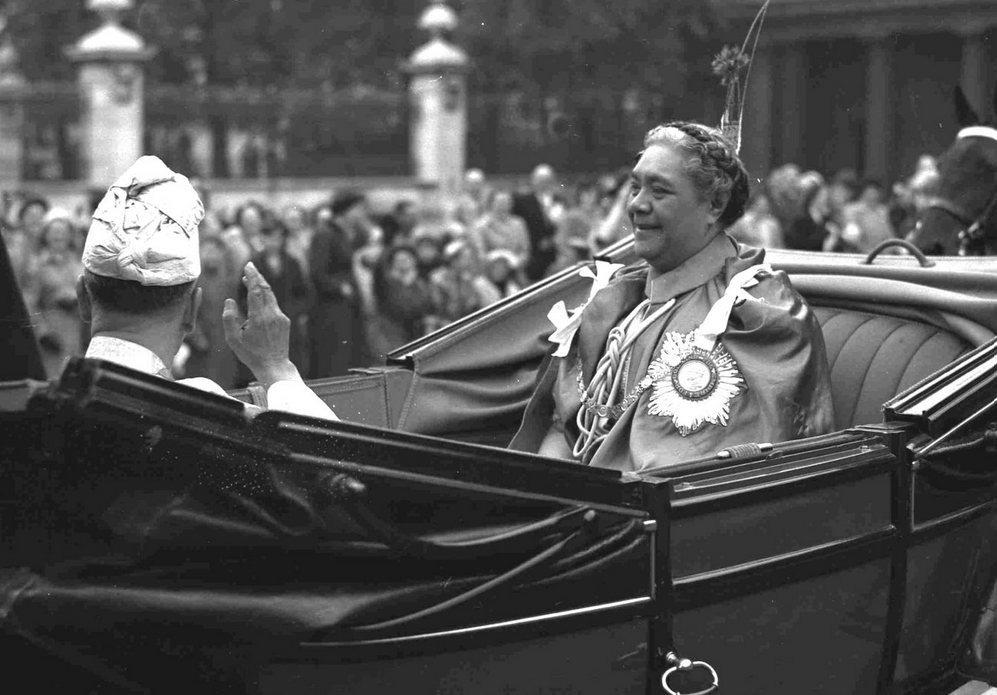
Each rank of peers – Dukes, Marquesses, Earls, Viscounts, and Barons – was represented by the most senior of their number to pay homage to their sovereign. As a bankrupt, the nonagenarian Marquess of Winchester was disqualified from representing the Marquesses but his extraordinary wife, Bapsy, still had her portrait painted in her coronation robes as if she had attended.
The 25th Lord Mowbray, Segrave and Stourton (his first title dating from 1283) representing the barons, was sat in front of the Dukes. When his son told him how lucky he was to have such a good seat, he shot back, “Lucky? Lucky? These upstart Dukes were still tilling the fields when we were Barons.” He had his comeuppance. The Duke of Rutland stole his coronet, and his 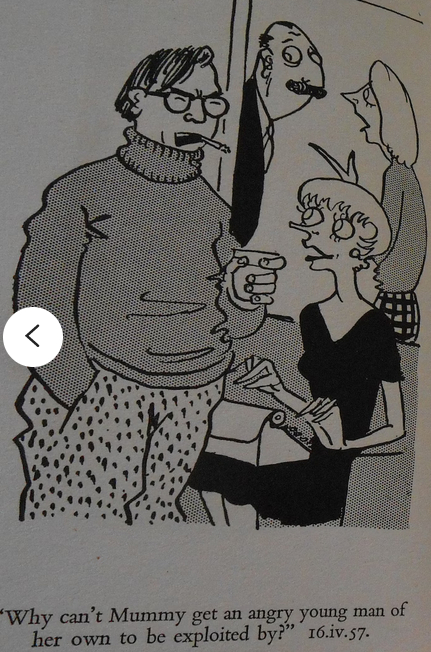 sandwiches within it.
sandwiches within it.
In the run-up to the 1953 coronation, the brilliant Osbert Lancaster, master of the pocket cartoon, had much fun with his glorious creation monstre sacré – Maudie Countess of Littlehampton. Maudie was a political grande dame whose topical, hilarious bon mots and put-downs, appeared in Lancaster’s pocket cartoons for The Daily Express from the late 40s until 1981. Maudie (left) was inspired by a number of women, among them an old girlfriend and Lancaster’s second wife but chiefly by one of the Golden Guinness Girls, Maureen, Marchioness of Dufferin and Ava. (Maureen’s other distinction is that Barry Humphries copied her spectacles for Dame Edna). Among Maudie’s appearances in Vickers’ book is one of her buying pate from her grocer, ‘You know – the size that fits into an earl’s coronet & still leaves room for a packet of biscuits & an apple’. Alas, seventy years on, with the congregation quartered, neither Maureen nor Maudie would have been invited to this Coronation.
Sustenance and bladder control seem such vulgar topics to raise but the marathon that was the Coronation called for great self-discipline. Poor 80-year-old Princess Marie Louise, a granddaughter of Queen Victoria, attending her fourth coronation, was so thirsty at the end of the ceremony she drank a whole bottle of water. It turned out to be gin and on her way home she was close to falling out of her carriage.
Friends of the Royal Family were assigned seats in the Royal Box. It was said that in 1902 Edward 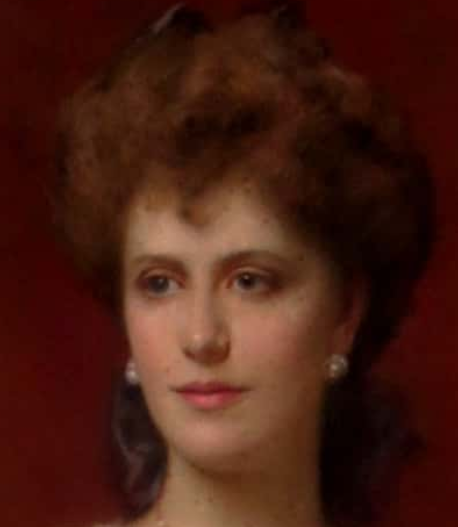 VII invited his mistresses so it was dubbed the ‘Loose Box’. It is fascinating to think that one of King Edward’s guests was La Favorita, Alice Keppel (right), who happens to be great-grandmother of Queen Camilla.
VII invited his mistresses so it was dubbed the ‘Loose Box’. It is fascinating to think that one of King Edward’s guests was La Favorita, Alice Keppel (right), who happens to be great-grandmother of Queen Camilla.
A unique aspect of Saturday’s Coronation is that the Queen Consort’s first husband will be an honoured guest at Her Coronation and will witness his grandsons carrying the train of their grandmother as she processes to be crowned. Andrew Parker Bowles also has the distinction of being one of only a dozen surviving participants in the last coronation, when, as a 13-year-old, he was chosen as a page by Lord Simonds, the Lord Chancellor, who happened to be a friend of his mother. The young Andrew behaved impeccably but his Lordship suffered his own mishap when his coronet, fitted to sit on his judicial wig, fell onto his face.
While his mother’s coronation was unswervingly Anglican, Charles has said that he would prefer to be ‘Defender of Faiths’ – more than a gesture to the millions of Muslims, Hindus, Sikhs, Buddhists and Catholics among his subjects. And so on Saturday their leaders will all be present.
In 1953, Bernard Griffin, the Catholic Archbishop of Westminster, would not enter the Abbey, a Protestant church. On Saturday his current successor, Vincent, Cardinal Nichols, will not only be inside the Abbey but will impart a blessing on the King immediately after the crown has been placed on his head. The Tablet believes the last time a cardinal was involved in a coronation was in 1543, when David, Cardinal Beaton presided at the crowning of the infant Mary Queen of Scots at the Chapel Royal in Stirling Castle. Meanwhile, Ephraim Mirvis, the Chief Rabbi, has been invited to stay at St James’s Palace on Friday night so he can walk to Westminster Abbey, as vehicular travel is prohibited on the Jewish sabbath
And now to the soul of the ceremony. The primary source for the service came from Edward II’s coronation (below) in 1308 but elements were drawn from as far back as the crowning of King Edgar in 793. A solidly arcane ritual was in place on that wet morning of June 2 in Westminster Abbey in 1953 when the 99th Archbishop of Canterbury, Geoffrey Fisher, placed the King Edward Crown on the young head of Elizabeth II.
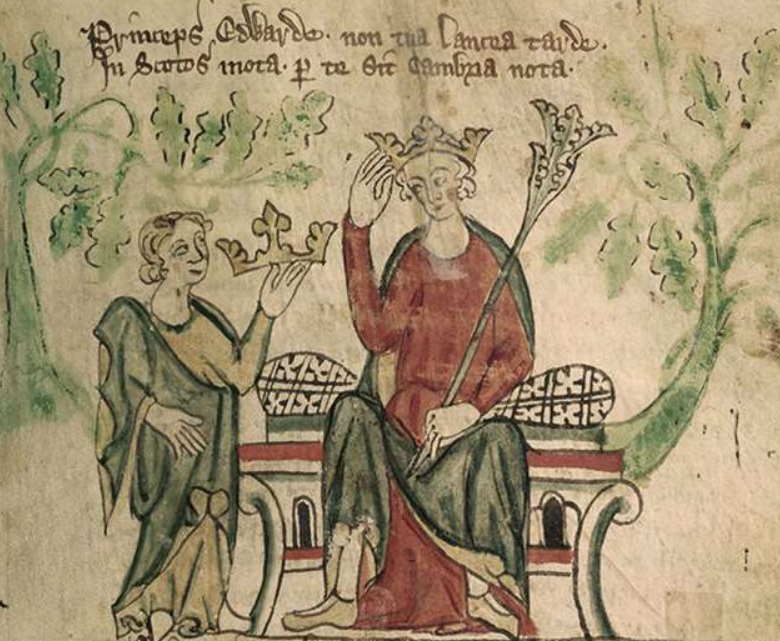
The Archbishop had just anointed her with the ancient words:
As kings, priests and prophets were anointed, and as Solomon was anointed king by Zadok the priest . . . so be thou anointed, blessed and consecrated Queen over the peoples whom the Lord thy God hath given thee to rule.
Time magazine described the moment:
The Crown itself sparkled in the candlelight. The Archbishop of Canterbury moved to the high altar, clasped it in both hands and raised it before him. “Oh God, the Crown of the Faithful,” he prayed, “bless, we beseech Thee, this Crown, and so sanctify Thy servant Elizabeth, upon whose head Thou dost place it . . . that she may be filled by Thine abundant grace, with all princely virtue.
With the Crown borne before him, Canterbury approached the Queen. He raised it high above her, paused for all to see, and placed it on her head.” The congregation, now her subjects, cried out: “God save the Queen! God save the Queen!”
Trumpets sounded, a thousand peers and peeresses rose and put on their coronets and then the Archbishop, Prince Philip, her uncle Gloucester, her cousin Kent, and those representatives from the five degrees of the peerage (dukes, marquesses, earls, viscounts and barons) all paid homage. Then again came a roar throughout the Abbey:
“God save Queen Elizabeth!
Long live Queen Elizabeth!
May the Queen live forever!”
Until last year, it seemed that she might. But what seems certain is that the young Queen saw the ceremony as a solemn pact with her God and with her people. This was no mere investiture. As the late Ben Pimlott put it (in his superb biography, The Queen) “Not all the water in the rough rude sea,” wrote Shakespeare wrote in Richard II, “can wash the balm from an anointed king.” The ceremony sanctified the pledge she famously made in Africa, eight years earlier on her 21st birthday. “I declare before you all that my whole life, whether it be long or short, shall be devoted to your service and the service of our great imperial family to which we all belong.”
Charles attended his mother’s coronation. “Look, it’s Mummy” he exclaimed. He was only four so his memory of it must be faint, although a witness claimed that, as his mother took the Sovereign’s Sword, advanced with it to the altar and offered it to God, he watched enraptured.
As Pimlott observed, the coronation “was the most magnificent and affecting royal ceremonial of the century – despite, or because of, the decline in the importance of the Monarch.” He also considered that it “helped to define, not just royalty, but the British identity for the next generation.”
The historian, Sir Charles Petrie, wrote of the Queen, “For the first few years of her reign, she was the subject of adulation unparalleled since the days of Louis XIV.” At the age of 25 and at the height of her beauty, she held much promise for Britain, still drained and rationed after the war. A new Elizabethan Age was declared. Charles III, now beyond his biblical allotment of three score years and ten, as St Edward’s Crown is placed on his head. No heir could be better prepared.
Vivat Rex!
 Sign In
Sign In 0 Items (
0 Items ( Search
Search









Pomp and pageantry aside plus of course a hard act to follow after his mother, we must be thankful that we have a monarch who cannot meddle with our country else we would have the likes of (the list is too long for this August journal) as a president who could and would, bugger the country properly so we must wish the new King all the best.
I expect King Charles’s reign to mimic that of his great great grandfather Edward VII ,both in length and success.
Plus the womanising?
Edward VII was actually a very successful King, and probably the finest diplomat of the time. His diplomacy was vital in securing an alliance with France after centuries of conflict (there are still hotels bearing his name in Paris) and then Russia after a century of conflict and competition.
I think a monarch is a great idea, I fully support it, and K. Charles 3; particularly that he is domiciled in and funded by another country. A great boon to us here in Oz. A king for free!
And now to War to war while this pageantry covers the States panic self inflictions.
He’s no Edward 1 or Henry V that’s for sure, and I think he should have stuck to the traditional Defender of the Faith, but in spite of his erroneous ideas on the non existent, unnatural global warming scam I think his strong sense of loyalty and duty will see him through. He has my support, as does our constitutional monarchal system generally.
The Coronation of King Edgar took place in 973, not 793. As it is, the core elements of the Coronation ritual of last Saturday were taken from King Edgar’s, more or less codified in the book for that of King Edward II in 1301. Watching the ceremony in the Abbey on Saturday one was struck by the “mediaeval” feel of much of what was going on, all the more satisfying for that, overlaid with Thomas Cranmer’s beautiful words from The Book of Common Prayer.